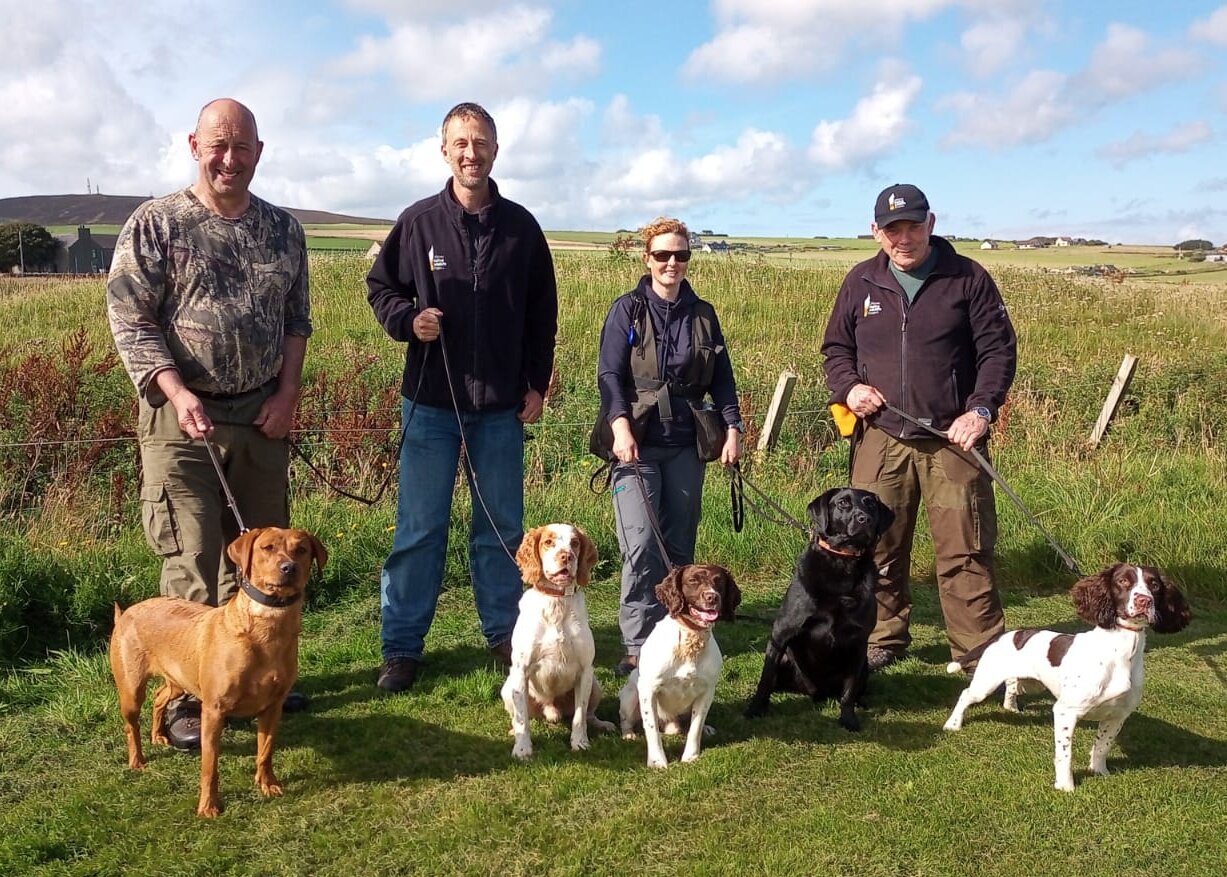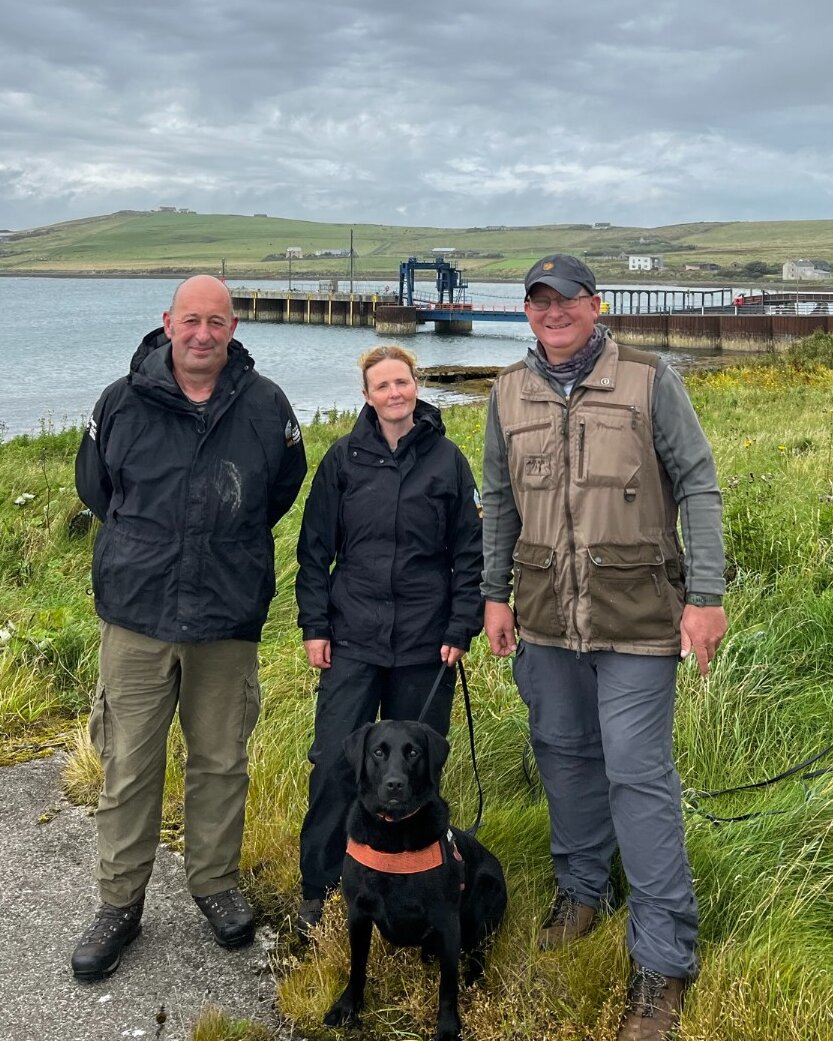The latest arrivals to join the Orkney Native Wildlife Project (ONWP) dog team are tracker dog Red, and Sky, a stoat scat detection dog. Spud, who joined the project in May 2021 as a stoat detection dog, has also recently returned to Orkney after being retrained as a tracker dog with canine training specialists, Kryus Ltd.
The new arrivals, Red and Sky, will spend their first month getting used to the Orkney environment, and bonding with their handlers before working in the field. The squad will work on a mix of island biosecurity to check for signs of stoats on high-risk islands close to the Orkney Mainland in addition to supporting the project’s eradication operations.

Chris Bell, ONWP Biosecurity Officer added: “A dog’s nose has between 220,000 and 300,000 receptor cells compared to only 5,000 in a human nose. As a dog’s brain can process those smells up to 60 times more than humans, our dog teams are an exceptional asset to biosecurity. Alongside crucial public sightings and the support from island communities, the dog teams give us the strongest possible early warning system to any signs of stoats on the high-risk islands. The dog teams also demonstrate absence of stoats more efficiently and effectively than human searches alone.”
These working dogs are trained to not hunt or attack stoats and will always be controlled by their ONWP dog handlers, now increased to a team of four from the original three.
Spud’s career with the project began in May 2021 alongside first arrivals Scout and Thorn. These were the first stoat detection dogs in Europe. Scout and Thorn, along with new arrival Sky, will continue to search out signs of stoats in the landscape. Instead of being directed to find signs of stoats, the tracker dogs Red and Spud are trained to lead their handler to the home territory or den of a stoat. The trapping team will then use the information provided by the dog team to know where best to lay traps in the stoat’s territory to bolster the trap network of over 6,000 traps.
The dogs were integral to the trials of the eradication mop-up methods tested in Deerness during the spring and summer this year. Within 24 hours of receiving the public report of a stoat sighting, the dog teams would work the area alongside the trapping team to seek out signs of stoats so the trapping specialists would adapt the network for a successful catch.
Lianne Sinclair, ONWP Project Implementation Manager said: “It is very exciting embarking on this new chapter with our dog team. The tracker dogs work in a completely different way to detection dogs, which means additional training and skill development for their human handlers. The most obvious difference is that the detection dogs are directed by their handler, whereas the tracker dogs lead their handler following the scent and the track. It is incredible to see the precision at work in the field as the handlers use their skills and techniques to interpret the different signs from a tracker or a detection dog - which is truly impressive.”
Editor's notes

About the Orkney stoat conservation detection and tracker dogs
- There are six dogs in the ONWP team. Two tracker dogs Red is a Fox Red Labrador and Spud, is a black Labrador. Detection dogs are Scout (Sprocker), Riggs, Thorn, Sky (all Springer Spaniels).
- Where appropriate and requested, dogs will be kept on a leash and can be muzzled. The team only search on land where permission has been given. They will always check with landowners ahead of any visit to ensure no disturbance to farming operations.
- The dogs are supplied by Kryus Ltd which are a specialist canine services company established in March 2016 by Frank Holmes. He has been working with dogs for over 30 years rising to Chief Trainer with the British Army Veterinary Corps. Sian Parry worked for the Lancashire Wildlife Trust and since joining Kryus Ltd, has brought a greater awareness of conservation to the company.
About Orkney biosecurity and trapping
- The mop-up phase of an eradication is when we estimate that more than 90% of the population of stoats has been removed in any given area. Regular analysis of field data is used to predict what percentage of the population has been removed and so determine when the project is ready to move from the initial knockdown phase (when the bulk of stoats are caught) to the mop-up phase.
- Biosecurity is the description for the methods that help prevent the spread of invasive non-native species - in Orkney’s case this is the stoat.
- Invasive non-native migrations are usually a human-made problem, so it is critical that plans are put in place to stop stoats spreading across Orkney now, as well as preventing their return in the future once they have all been removed.
- Stoats have been known to swim up to three kilometres, so a shoreline network of traps exist to catch any potential stoat reaching the neighbouring isles as an early warning system of stoats spreading.
- We collaborate with each island community to create biosecurity plans specific to their needs which set out the actions to help prevent stoats spreading to their stoat-free isles.
- High-risk islands are those that are currently stoat-free but that are within a swimmable distance of Orkney Mainland. Stoats are excellent swimmers and have been known to swim up to three km in open water. There are also many smaller islands that they could use as steppingstones which puts islands such as Hoy, Shapinsay, Rousay, Flotta, Wyre, Egilsay, Eynhallow and Graemsay within reach of stoats.
About the Orkney Native Wildlife Project
- Facebook page www.facebook.com/OrkneyNativeWildlifeProject
- The ONWP is the world’s largest stoat eradication project in a populated place.
- The Orkney Native Wildlife Project is a partnership between RSPB Scotland, NatureScot and Orkney Islands Council, with the aim to protect Orkney’s native wildlife by removing stoats, an invasive non-native predator first recorded in Orkney in 2010.
- It has the generous support of the National Lottery through the National Lottery Heritage Fund and EU Life as well as financial and in-kind contributions from partners.
Stoats in Orkney
- Stoats are native to the UK Mainland but not to Orkney. They were first recorded in Orkney in 2010. In 2014, Scottish Natural Heritage commissioned a report: Stoat on the Orkney Islands – assessing the risks stoats posed to native species (SNH Commissioned Report No. 871).
- Stoats are very skilled hunters. They are fast and agile and good climbers with very good eyesight, hearing and sense of smell. They typically feed on small mammals, birds and eggs but can kill prey much larger than themselves. They also tend to kill more than they need and hide (cache) the rest to eat later. With no natural predators in Orkney, they pose a very serious threat to Orkney's native wildlife.
- Stoats are a particular threat to the Orkney vole, hen harrier, short-eared owl and other ground-nesting birds such as red-throated divers, Arctic terns and curlews for which Orkney is internationally important and upon which Orkney’s thriving wildlife tourism industry relies.
- The introduction of stoats elsewhere in the world has had a devastating impact on island wildlife. For example, in New Zealand they are implicated in the extinction of the bush wren, laughing owl and native thrush.

